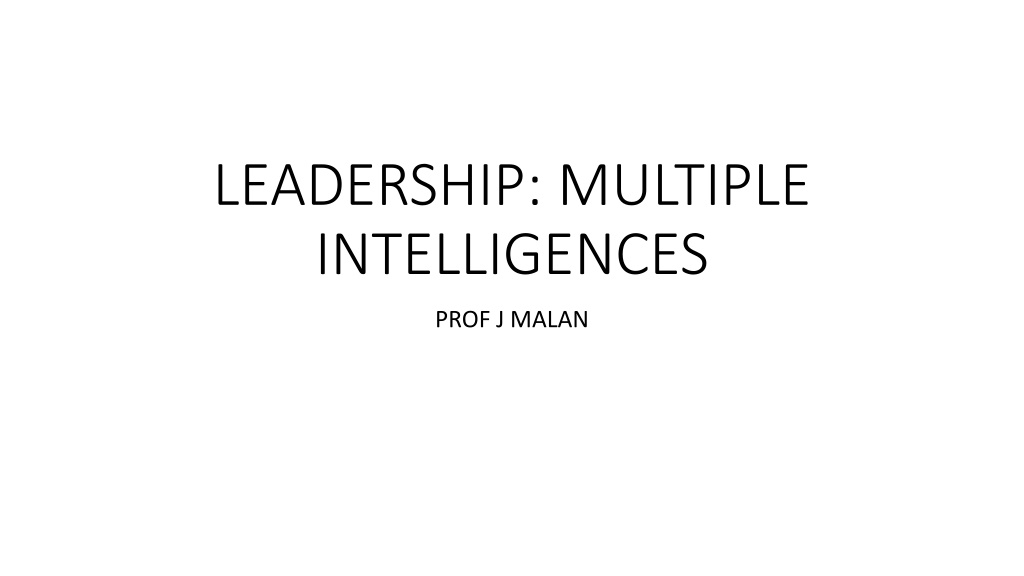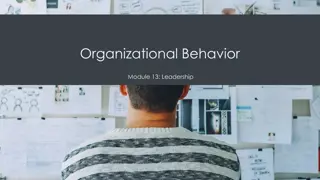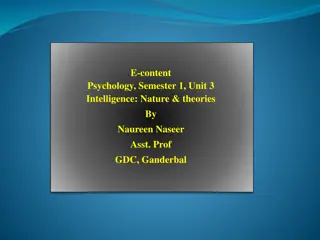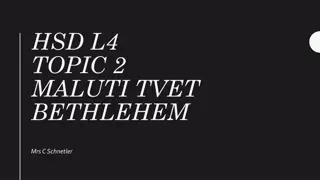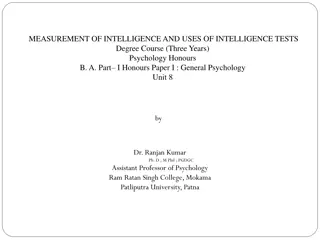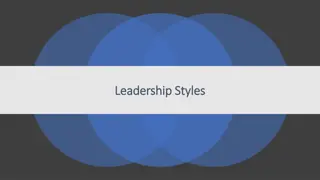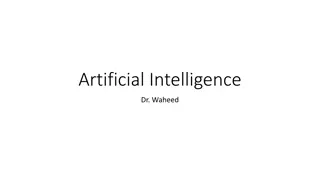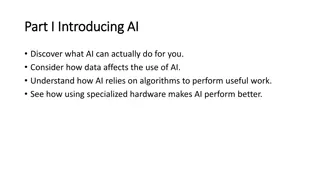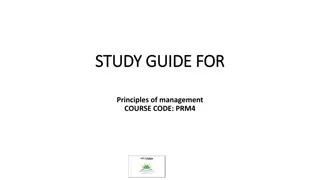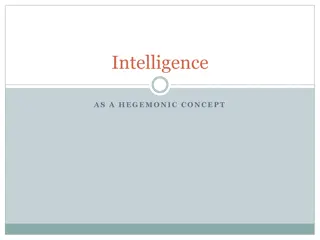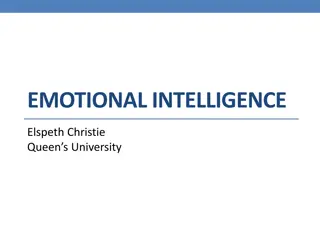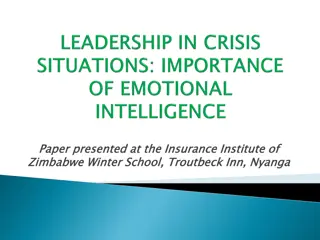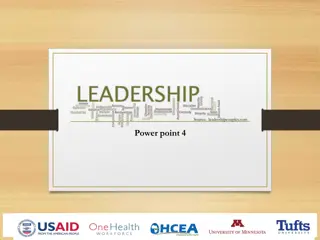Understanding Successful Intelligence in Leadership by Prof. J. Malan
Successful intelligence in leadership involves a balance of analytical, practical, and creative abilities. Fiedler and Link suggest that intelligence predicts leadership success under low-stress conditions, highlighting the interaction between stress, intelligence, and leadership. Leaders must analyze situations, have a vision for guiding people, and possess social intelligence to navigate challenges at different organizational levels.
Download Presentation

Please find below an Image/Link to download the presentation.
The content on the website is provided AS IS for your information and personal use only. It may not be sold, licensed, or shared on other websites without obtaining consent from the author. Download presentation by click this link. If you encounter any issues during the download, it is possible that the publisher has removed the file from their server.
E N D
Presentation Transcript
LEADERSHIP: MULTIPLE INTELLIGENCES PROF J MALAN
Fiedler and Link (1994) have suggested that intelligence predicts leadership success under conditions of low stress but not under conditions of high stress, where experience becomes more important. The first consideration is therefore the interaction between stress, intelligence and leadership
Successful intelligence Successful intelligence is the ability to achieve success by one s own standards, given one s sociocultural context. People have understood their own strengths and weaknesses and, to a large extent, made the most of them. Those who do not do so the Richard Nixons (who cannot conquer their morbid distrust of others) and the Joseph Stalins (who, in their monomaniacal need for absolute power, destroy so many others and become notorious and infamous rather than respected and famous) pay the price and so, unfortunately, do the people whom they lead.
successful intelligence involves a balance in the use of analytical, practical, and creative abilities
Analytical The ability to analyse available information in order to make decisions
Practical Practical intelligence: is important not only for adaptation to existing environments, Military vs Commercial but also for shaping of such environments to transform them.
Creative Leaders need not only to adapt to be practical in their roles as leaders, but to shape and thus to be creative as well. They need to formulate a vision of where to lead. Creative intelligence can help them in this regard.
leaders need not only analyze existing situations, but also need to have a vision of where to lead people (creative intelligence) and of how to get them there to convince them that this is indeed where they need to go (practical intelligence).
Social intelligence Different levels of the organization puts different challenges to leaders. The higher the level, the more difficult the need to perceive and interpret social cues in a more ambiguous environment. A broader, more complex environment. Ability to understand the feelings, thoughts, and behaviours of persons, including oneself, in interpersonal situations and to act appropriately upon that understanding
Emotional Intelligence The capability of individuals to recognize their own, and other people's emotions, to discern between different feelings and label them appropriately, to use emotional information to guide thinking and behaviour, and to manage and/or adjust emotions to adapt to environments or to achieve goal(s).
The four components of emotional intelligence Identifying Emotions Using Emotions Understanding Emotions Managing Emotions
Competencies and categories 25 competencies 5 Categories Self-Awareness (emotional awareness, accurate self-assessment, self-confidence); Self-Regulation (self-control, trustworthiness, conscientiousness, adaptability, innovation); Motivation (achievement, commitment, initiative, optimism); Empathy (understanding others, developing others, service orientation, diversity, political awareness); and Social Skills
The role of ability How emotions can facilitate thinking and adaptive behavior. It has to do with how people think, decide, plan, and create. Second, the ability model of emotional intelligence is skill-based.
Placing leadership into context If we wish to examine leadership-emotional intelligence relationships, then we must first understand what it is that leaders do. Management is focused on specific functions or activities: planning, motivating, organizing and control. Leadership is the influencing of others in order to achieve a goal.
The modern workforce Focussed on creativity Recognised as a valuable asset Pressure on performance Productivity Large emphasis on freedom of thinking due to information availability
The link between leadership and emotional intelligence Using Emotions allows leaders to understand and motivate others by making emotions available, engage in multiple perspectives that can help planning, and engage in activities facilitated by emotions (e.g., detail work when feeling neutral or down, or creative brainstorming activities when feeling happy).
Can emotional intelligence be taught Anecdotal evidence from executive coaching programs indicates that emotional knowledge can be taught, and that doing so sometimes can have dramatic impact on a leader and an organization.
The ultimate test of leadership is team performance. poor social skill undermines leadership, and the evidence clearly supports this view When managers fail, they do so primarily because they are unable to understand other peoples perspectives. This inability makes them insensitive to others, unable to build a team, and consequently, unable to get their work done because they have to accomplish their work through the efforts of others
In the process of social interaction, the two key variables underlying every evaluation are trust and liking. People have an inherent need to be liked, inter-act, recognised etc Not being trusted destroys the ability of any leader. Being insensitive causes others either not to trust or not to like the potential leader, or perhaps both at the same time. People who are not trusted or not liked will have trouble building a team.
leadership is a function of personalityleaders are people who excel at the process of getting along and getting ahead
The role of cognitive resources What are the obstacles that prevent a leader s intellectual abilities and other cognitive resources from contributing to the effective performance of the task? Cognitive = mental processes of perception, memory, judgment, and reasoning, as contrasted with emotional and volitional processes
Cognative resources Common sense tells us that leadership requires such cognitive resources as intelligence, experience, and technical knowledge. Stogdill, 1948; Ghiselli, 1963; Fiedler, 1970 Cognitive resources as intellectual abilities, expertise, and experience by themselves do not predict leadership performance to any appreciable degree Studies had weaknesses in their sampling and methodology
Stress Performance under stress affects use of cognitive resources Under high stress, leaders use their experience but misuse their intelligence; under low stress, leaders use their intelligence but misuse their experience. Experience is definitely an intellectual function Stress has the effect of causing the individual s manner of behaviour and thinking to regress to a less mature level Therefore stress reduction training can improve a leader s functionality
Summary of the three types of intelligence Cognitive intelligence Social intelligence Emotional intelligence
Transformational Leaders transactional leadership emphasizes the exchange that takes place among leaders, colleagues, and followers in which the leader discusses with followers what is required and its consequences if they do or don t fulfill those requirements transformational leaders achieve superior results by raising followers consciousness about goals and values, by arousing needs higher on Maslow s hierarchy and motivating followers to go beyond their own individual interests for the good of the group, organization, or society. They employ one or more of the four components of transformational leadership.
While authentic transformational leaders can be trusted, Pseudo-transformational leaders ask to be trusted, but cannot be trusted. Multiple intelligences, particularly social and emotional, contribute to the frequency with which individual leaders are seen as transformational.
The Motivational Dimensions of Leadership Leaders have followers Leader effectiveness is judged by how they manage followers to achieve goals = motivation Motivation = Power, Achievement, and Affiliation three major human motives: the drives for power, achievement, and affiliation
motivational prescription for effective leadership would therefore involve some degree of balance: balance between achievement and power concerns, balance or tempering of power with responsibility or similar forms of control, and balance among the benefits and liabilities of affiliative concerns. The motives of leadership are a little like fire: they can cook our food and keep us warm, but they must always be controlled, trimmed back, and guarded lest they burn and destroy our homes, our institutions, and ourselves.
Leadership effectiveness Leadership effectiveness depends on the leader behaving in a manner that (1) elicits the trust and loyalty of followers (image management); (2) motivates followers toward enthusiastic effort (relationship development); and (3) applies the efforts, knowledge, and material resources of the group to mission accomplishment (resource deployment)
Leader Self-Regulation The leader and him-/herself Self motivation How people think, feel, and act about themselves affects their tendencies to lead Self-leadership
Cultural intelligence new research terrain Cultural intelligence as a life skill in today s pluralistic societies that is particularly relevant to those who seek to lead. Individualism Collectivism Power distance Uncertainty avoidance Masculinity/femininity
Self-assessment Male-female attributes
